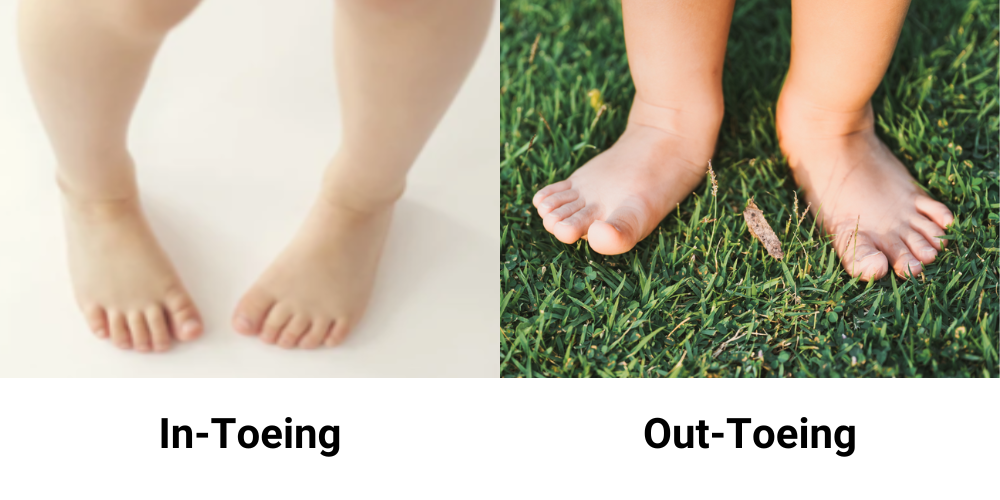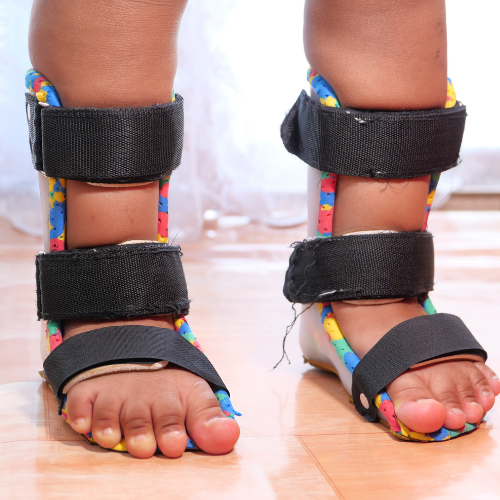The Myth and Reality of In-Toeing and Out-Toeing
February 1, 2024Have you ever found yourself marveling at your little one’s unique walking style? Those adorable little toes of theirs pointing inward or outward might seem like a quirky phase they’ll grow out of, but that’s a common misconception. Let’s dive into the myth and reality of in-toeing and out-toeing in kids and why pediatric physical therapy might be just what the doctor ordered.

When little ones initially start walking, it is common to see some bowing (bending outwards) at the knees, while maintaining knee and foot alignment. At two years-old, we expect our tiny tots to conquer walking, stairs, and climbing with their feet pointing forward. By three years-old, those little piggies should ideally be in line, meaning their feet should be in line with their knees and tibias. But what happens when the journey takes a zigzag detour?
The easiest way to tell if your child is in-toeing or out-toeing is to watch their feet while they walk. If their feet are not facing forward in a straight line, they may need professional intervention. Another way to determine if they may be exhibiting signs of this is if their legs look like they’re making the letter W while they’re sitting and playing on the floor, or if they’re falling over or losing their balance more often than what seems normal for their age. In all these cases you should ask your pediatrician or primary care provider to make a referral to have their stance and gait reviewed by a pediatric physical therapist to determine if they would benefit from ongoing physical therapist at the Schreiber Center for Pediatric Development to retrain their gait and posture.

Ignoring in- and out-toeing can lead to several more serious complications. These rotational deviations can cause muscle imbalances, gait inefficiencies, and even osteoarthritis of the knee. While muscle imbalances and gait inefficiencies can be worked on and improved in physical therapy as your child ages, once osteoarthritis of the knee begins, there is no way to reverse it, which is why pediatric physical therapy for in- and out-toeing is so important. Another common issue seen with in-toeing and out-toeing is foot overpronation, which can cause the arches of their tiny feet to flatten more than they normally would, which increases their risk of foot and leg injury. It is critical to address any rotational issues as soon as possible because as children age, it is hard to make changes to their bony structure.

There are another several reasons behind why a child might walk in a in-toe or out-toe style including: w-sitting habits, ligament laxity, pelvic instability, low muscle tone, poor trunk control or femoral rotation, and the solution to them all is pediatric physical therapy. By working with a pediatric physical therapist at the Schreiber Center, kids can work on targeted exercise to strengthen the muscles in the affected areas and learn how to use these strengthened muscles to stand and walk with correct posture promoting neutral alignment. They may also be fitted for orthotics or Togrite Strapping to support their feet and promote proper alignment while they attend physical therapy sessions to improve their balance, coordination, and flexibility.

The most important and impactful aspect though, is making sure that in- and out-toeing is caught early, and addressed through pediatric physical therapy as soon as possible. By addressing these concerns as soon as you notice them, you are providing your child with a greater chance to develop healthy posture and gait and minimize the risks of long-term complications associated with in- and out-toeing.
Author’s Note:
The valuable insights and information shared in this article were provided by the Schreiber Center for Pediatric Development’s pediatric physical therapist Rachel D’Arcy. Rachel has a wealth of experience in pediatric physical therapy, and her expertise has been instrumental in crafting the content of this piece.
If you are interested in learning more about how Schreiber’s Pediatric Physical Therapy Services can help your child visit https://www.schreiberpediatric.org/physical-therapy/
As a nationally recognized pediatric facility, the Schreiber Center for Pediatric Development provides family-centered education and therapy programs for infants, children and adolescents with disabilities, developmental delays, and acquired injuries. Our goal-oriented approach maximizes each child’s ability to function independently within the community.